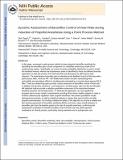| dc.contributor.author | Chen, Zhe | |
| dc.contributor.author | Purdon, Patrick L. | |
| dc.contributor.author | Harrell, P. Grace | |
| dc.contributor.author | Pierce, Eric T. | |
| dc.contributor.author | Walsh, John | |
| dc.contributor.author | Brown, Emery N. | |
| dc.contributor.author | Barbieri, Riccardo | |
| dc.date.accessioned | 2012-04-12T19:35:51Z | |
| dc.date.available | 2012-04-12T19:35:51Z | |
| dc.date.issued | 2010-10 | |
| dc.date.submitted | 2010-05 | |
| dc.identifier.issn | 0090-6964 | |
| dc.identifier.issn | 1573-9686 | |
| dc.identifier.uri | http://hdl.handle.net/1721.1/70006 | |
| dc.description.abstract | In this article, we present a point process method to assess dynamic baroreflex sensitivity (BRS) by estimating the baroreflex gain as focal component of a simplified closed-loop model of the cardiovascular system. Specifically, an inverse Gaussian probability distribution is used to model the heartbeat interval, whereas the instantaneous mean is identified by linear and bilinear bivariate regressions on both the previous R−R intervals (RR) and blood pressure (BP) beat-to-beat measures. The instantaneous baroreflex gain is estimated as the feedback branch of the loop with a point-process filter, while the RRBP feedforward transfer function representing heart contractility and vasculature effects is simultaneously estimated by a recursive least-squares filter. These two closed-loop gains provide a direct assessment of baroreflex control of heart rate (HR). In addition, the dynamic coherence, cross bispectrum, and their power ratio can also be estimated. All statistical indices provide a valuable quantitative assessment of the interaction between heartbeat dynamics and hemodynamics. To illustrate the application, we have applied the proposed point process model to experimental recordings from 11 healthy subjects in order to monitor cardiovascular regulation under propofol anesthesia. We present quantitative results during transient periods, as well as statistical analyses on steady-state epochs before and after propofol administration. Our findings validate the ability of the algorithm to provide a reliable and fast-tracking assessment of BRS, and show a clear overall reduction in baroreflex gain from the baseline period to the start of propofol anesthesia, confirming that instantaneous evaluation of arterial baroreflex control of HR may yield important implications in clinical practice, particularly during anesthesia and in postoperative care. | en_US |
| dc.description.sponsorship | National Institutes of Health (U.S.) (Grant R01-HL084502) | en_US |
| dc.description.sponsorship | National Institutes of Health (U.S.) (Grant K25-NS05758) | en_US |
| dc.description.sponsorship | National Institutes of Health (U.S.) (Grant DP2- OD006454) | en_US |
| dc.description.sponsorship | National Institutes of Health (U.S.) (Grant T32NS048005) | en_US |
| dc.description.sponsorship | National Institutes of Health (U.S.) (Grant T32NS048005) | en_US |
| dc.description.sponsorship | National Institutes of Health (U.S.) (Grant R01-DA015644) | en_US |
| dc.description.sponsorship | Massachusetts General Hospital (Clinical Research Center, UL1 Grant RR025758) | en_US |
| dc.language.iso | en_US | |
| dc.publisher | Springer-Verlag/Biomedical Engineering Society | en_US |
| dc.relation.isversionof | http://dx.doi.org/10.1007/s10439-010-0179-z | en_US |
| dc.rights | Creative Commons Attribution-Noncommercial-Share Alike 3.0 | en_US |
| dc.rights.uri | http://creativecommons.org/licenses/by-nc-sa/3.0/ | en_US |
| dc.source | PubMed Central | en_US |
| dc.title | Dynamic Assessment of Baroreflex Control of Heart Rate During Induction of Propofol Anesthesia Using a Point Process Method | en_US |
| dc.type | Article | en_US |
| dc.identifier.citation | Chen, Zhe et al. “Dynamic Assessment of Baroreflex Control of Heart Rate During Induction of Propofol Anesthesia Using a Point Process Method.” Annals of Biomedical Engineering 39.1 (2010): 260–276. Web. | en_US |
| dc.contributor.department | Harvard University--MIT Division of Health Sciences and Technology | en_US |
| dc.contributor.department | Massachusetts Institute of Technology. Department of Brain and Cognitive Sciences | en_US |
| dc.contributor.approver | Brown, Emery N. | |
| dc.contributor.mitauthor | Brown, Emery N. | |
| dc.contributor.mitauthor | Chen, Zhe | |
| dc.relation.journal | Annals of Biomedical Engineering | en_US |
| dc.eprint.version | Author's final manuscript | en_US |
| dc.type.uri | http://purl.org/eprint/type/JournalArticle | en_US |
| eprint.status | http://purl.org/eprint/status/PeerReviewed | en_US |
| dspace.orderedauthors | Chen, Zhe; Purdon, Patrick L.; Harrell, Grace; Pierce, Eric T.; Walsh, John; Brown, Emery N.; Barbieri, Riccardo | en |
| dc.identifier.orcid | https://orcid.org/0000-0003-2668-7819 | |
| mit.license | OPEN_ACCESS_POLICY | en_US |
| mit.metadata.status | Complete | |
